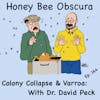Dealing With Fall Equipment (148)

After all of the nectar has flowed, the honey spun and you’re just waiting to put the bees to bed for the winter, you might look around at the clutter of equipment in your bee yard, bouncing in the back of your bee truck or shoved aside in the bee...
After all of the nectar has flowed, the honey spun and you’re just waiting to put the bees to bed for the winter, you might look around at the clutter of equipment in your bee yard, bouncing in the back of your bee truck or shoved aside in the bee hut. Is there a better way to store that equipment so it is ready to use come Spring?
In this week’s episode, Jim invites Beekeeping Today Podcast’s Jeff Ott to sit in for Kim to talk about dealing with equipment in the fall. How do you protect your woodenware and frames full of wax from mice, wax moths and other critters seeing it as a food-rich warm place to ride out the winter?
In this episode, Jim and his guest talk about dealing with equipment in the fall.
______________________
Thanks to Betterbee for sponsoring today's episode. Betterbee’s mission is to support every beekeeper with excellent customer  service, continued education and quality equipment. From their colorful and informative catalog to their support of beekeeper educational activities, including this podcast series, Betterbee truly is Beekeepers Serving Beekeepers. See for yourself at www.betterbee.com
service, continued education and quality equipment. From their colorful and informative catalog to their support of beekeeper educational activities, including this podcast series, Betterbee truly is Beekeepers Serving Beekeepers. See for yourself at www.betterbee.com
______________________
Honey Bee Obscura is brought to you by Growing Planet Media, LLC, the home of Beekeeping Today Podcast.
Music: Heart & Soul by Gyom, All We Know by Midway Music, original guitar music by Jeffrey Ott
Cartoons by: John Martin (Beezwax Comics)
Copyright © 2023 by Growing Planet Media, LLC

Episode 148 – Dealing With Fall Equipment
[music]
Jim Tew: Listeners here in Northeast Ohio, it's a brisk fall day. It has been strangely hot and typical for our modern day weather. Frost predictions are expected tonight and tomorrow, and what a day. Tomorrow will be compared to today. I was just sitting here thinking, it's time. Spring is gone, summer is gone, fall is here. It's time to get ready in this year to start something new. I've asked Jeff to come again and sit in for Kim, who's still on medical leave. It's a good time to say I'm not all that healthy myself. My voice sounds like I'm trying to sing in a choir or something, so don't hold that against me. I still want to talk about bees. You okay, Jeff, holding my hand while we do this?
Jeff Ott: I'm more than happy to be here. Thank you for asking me to join you.
Jim: I always enjoy talking to you. Hi, I'm Jim Tew.
Jeff: I'm Jeff Ott from Beekeeping Today Podcast.
Jim: As I hope you know, about once a week, we come to you and we talk about anything and everything beekeeping. Today, I'd like to go into exactly what are we going to do to store our unused equipment until we can start next year, which, Jeff, will be no doubt the perfect year.
Jeff: Absolutely. I'm counting on it.
Introduction: You are listening to Honey Bee Obscura, brought to you by Growing Planet Media, the folks behind Beekeeping Today Podcast. Each week on Honey Bee Obscura, hosts Kim Flottam and Jim Tew explore the complexities, the beauty, the fun, and the challenges of managing honey bees in today's world. Get ready for an engaging discussion to delight and inform all beekeepers. If you're a long-timer or just starting out, sit back and enjoy the next several minutes as Kim and Jim explore all things honey bees.
Jim: Jeff, through the years, I'm comfortable saying that I've tried it all. My dad had a storage barn. We put our bee equipment inside the building for winter. I can tell you straight up the mice were deeply appreciative of that. I've left it out in the yards. After all, it's painted, it's exterior equipment, so just leave it out.
Then I found that the raccoons would scatter it and screw it up some, but not every year, sometimes. What do you do with your equipment in the off-season? You've got quite a bit of investment in that. What do you do to protect it?
Jeff: I find that the biggest challenge going into the fall prepping for winter, the hives that are alive and healthy, those are easy to take care of, relatively speaking, not considering Varroa or anything else, but those are the easy ones. It's the deadouts, the hives that are sitting there that were last spring's hopeful colonies or that are now just deadouts. What do you do with that equipment? I don't know. I don't have a solid plan. The honey supers, I feel comfortable dealing with, but the brood boxes and the brood frames, which are valuable to have, how do you get them through the winter in one piece?
Jim: Everything you just said, I wanted to say, yes, I agree. Yes, I agree. Normally, conversation and stimulation comes from disagreement, but I don't have a clear plan. The honey supers are much more easy to manipulate because there's not enough protein source for wax moths. The mice will still chew them up, but not the end of the world. Boy, I'll tell you, the mice and warmer climates, wax moths really go for that old brood cone.
Jeff: All the wax moths just destroy a brood box. I have friends who will say, well, I just take out the brood frames and store them in a freezer for a couple of days, and then they're fine. Then I store them, wrap them tight or something with saran wrap or something, and stack them. It's just like, how big is your freezer?
Jim: That is exactly right. What do you have, a hive? If you can do that, listeners, it works. If you've only got one or two hives, freeze those frames, kill all stages of the wax moth and anything else you don't want there for the most part, and then take them back out or leave them there. I don't have freezer space to do that. It's ironic that you bring that up totally off the subject.
Yesterday, just yesterday, my dermatologist went off on a rant about bed bugs because they're a big issue in France. He said that on occasion, he has somebody will come into him with a rash, and they will find living functional bed bugs on them at that moment right here in my office while I was cringing all over. He said, "All you got to do is freeze it, put it in the freezer." I'm trying to imagine what my freezer looks like with corn a piece of chicken two bee boxes, and some clothes I think might have bed bugs on them.
This is getting to be a busy freezer, Jeff.
Jeff: This is way off the topic. Freezers in our household growing up, we had all sorts of animals growing up. My mom said that when she moved out of that house, she was pulling dead parakeets, dead mice, dead rats, dead whatever animals out of the freezer because our thought as boys growing up is if an animal died, we were going to study taxidermy someday or something like that. That dead animal went to the freezer. Anyways, that's way beside the point.
Jim: Why are we doing this? When you were talking, my daughter was just here who's very accusatorial. Dad, are you ever going to use this? I just hate that because then you got to defend why you kept that roll of wire and what you're going to do with all that paper that was just printed on one side. What she was talking about was I've got a case of bee diet in the refrigerator freezer here in my shop that takes up about half the space. If I take it out, here we go again with the mice, with the insects getting into my artificial diet so I keep artificial diet in my freezer too.
You and I have unintentionally discovered on trying to protect our equipment during the winter is that freezing is the universal way to go, either in a mechanical box or in the weather. Now having said that, being an Alabamian in South Alabama, there's not a lot of outdoor freezer space down there in the winter. For many of us, freezing is a perfectly viable option.
Jeff: Does freezing work for the small hive beetle? I've not dealt with small hive beetles.
Jim: Now you've caught me off guard. I only have a passing problem with small hive beetles. I don't know that. Would it freeze adults? I guess it would have to, Jeff. Listeners, we're guessing here. We have to guess. I know those of you in warm climates that have small hive beetles year round, this is not even a discussion worth listening to. For those of us who live in a deep freeze a good part of the year, I wonder if that freezes out the adults because the immatures are on the ground, and they would, I think, would strive to get below the frost line. We should have prepared a better thought on this before we got into freezing small hive beetles in an indoor freezer. We're just rambling all over here.
Jeff: I'm sure someone, hopefully, someone will write in and leave a message and let us know how they deal with small hive beetle during the winter months on dead-out equipment. I think that would be an interesting topic.
Jim: Good point. We'll ask the mass brain to help us out here.
Jeff: ChatGPT?
Jim: You can ask that too. Ask the computer system to give you the proper answer. It'll know. It'll know. Jeff, let's take a short break, reset ourselves, get back on the topic, say the comments we're supposed to say.
Betterbee: Are your bees ready to take on winter? Don't leave them vulnerable to Varroa mites. Introducing Api-Bioxal, the ultimate Varroa treatment for your honeybees. It's the only oxalic acid on the market that's EPA-approved to safely eliminate those pesky mites. Vaporize it. Dribble it. Do whatever it takes to ensure your Varroa numbers stay low as temperatures drop. Visit betterbee.com slash oxalic today to learn more and secure your ApeBioxal to send your bees into winter strong and healthy.
Jim: Honestly, Jeff, when it comes down to it, I leave most of my equipment outside all year. In fact, in Alabama, I'd actually store some of my equipment on top of an inner cover on top of the colony. I don't know why I put the inner cover on. I just did. It seemed like that would be a petition space to keep it going.
The weather wears on it. You got to repaint and it probably decays faster, but-- I've had buildings in the past, but they, there were always issues with the building. Did it have a cement floor? Was it an old dirt floor building? All of those things made a difference as to what I did. Then the big thing, Jeff, is how much equipment do you have? Do you have 2,000 deeps, or do you have six? Because what you do with it is significantly different.
Jeff: In the recent past, once the Sirtan or the Paramoth was available, I tried using that as opposed to mothballs on stored deep equipment. That seems to have worked, but there's that risk of using chemicals in the equipment that you have to make sure is aired out properly before you reintroduce bees to it. Have you ever worked with, what is it, Paradine? Paradichlorobenzene?
Jim: Yes, I have. In the old days, when everything chemical was fine, antibiotics, you can buy whatever you want. You could buy paradichlorobenzene all day from the bee supply companies and so on.
Instead of your whorl smelling faintly of propolis and wax, your whorl faintly had this mothball smell. If anybody's still trying that, do not please go by naphthalene, which has this, and it smells the same or similar, but naphthalene would adhere and was persistent. When you'd be eating your honey, you think, am I smelling mothballs in this honey? It was really would linger. We used to use that, other compounds that were available at the time we used to control wax moths, but I think it's probably a good thing that all went away. When you and I are talking about wax moths and small hive beetles and mice, we've actually been required to go chemical-free on these things. There's just not much available to control it.
Jeff: The paramoth, that's available now, that just came back out. That is available in the bee catalogs, but just use it carefully. It evaporates, so you have to constantly be using it.
Jim: I used to use it, I just don't anymore. I don't have nearly as many bees as I used to have, and this issue isn't as big as it used to be. This whole thing brings up another question that just, that Kim was always discussing, and that is how long do you want to keep those combs anyway? Do you really care that there's going to be some wax moth and mouse damage? Because probably, Kim would say three years, I would say probably five to seven, just because I'm lazier than Kim, but you wanted to recycle those frames out anyway. That the whole mentality of protecting those combs at any cost has moved on to the fact that those combs have a functional life, and there's no reason to go crazy preserving them for five, 10, 12 years.
Jeff: I agree with you, but back to our original point, the desire is to minimize the energy expenditure of the spring colonies by maintaining your existing comb from the prior season, getting those frames through to that point. You've told me once in keeping your hive boxes or hive bodies out, you sit them on their side so they're exposed to the fresh air and the light, and that helps with the wax moths.
Jim: The wax moths are gone here, Jeff. Do you have wax moths in the winter months in the Pacific Northwest? Listeners, Jeff, tell us where you're from, Jeff. In my garage. Tell us where you're from exactly right now. Olympia, Washington. Olympia, Washington. I'm in Ohio. Olympia, Washington. Yes. Spent a lot of time in the South, in Alabama, so it's different worlds. You have wax moths in your garage in the winter?
Jeff: When the hive bodies are sitting in there. The winters, we rarely get a deep freeze here. Deep freeze of a week is unusual. It might get down below freezing at night, but it'll get above freezing during the day. In terms of the Midwest from Ohio, where we'd have weeks of below-freezing temperatures, even during the day, we don't have that. We don't have that insect kill, the wax moth kill in empty equipment. It's viable pretty much throughout the season unless we get that weird season where it gets below freezing and stays that way for a week.
Jim: That was my experience, but more when I was keeping bees in South Alabama. We would have not as big a wax moth problem in the winter, but you would have wax moths year round. If in fact it does freeze tomorrow night, that'll be the first. Two more freezes, 30, 28, 17, that's it for wax moths till middle of next spring, late next spring. It doesn't take them that long to migrate back up, probably Southern Kentucky, back into Ohio, where they have been killed off because of the weather.
I did, Jeff. Those dead outs last spring, all that nice dark comb, those wax moths can really thrive in that. If you leave it set up, this is just Jim Tew now. This is not confirmed or this is not instruction. This is just old man desperation. If you leave those colonies set up as dead uts, they're really attractive to wax moths. I've read time and time again, if you expose the combs to light and you set on the sides, I've actually turned them on the ends because I could get the top back on.
Say, if you got those boxes sitting on an end, then the rainwater would stand in the handholds, and I was afraid would really expedite rotting there. When I set those colonies on the ends, I could put the top back on and put the brick back on there or my famous B rock and then keep the rain out of the handhold. Jeff, am I prepared to say that worked?
In the last two years, I've done it. The colony standing on end, two of them back to back, air passing through, exposed to light on the edge, had no wax moth. The colonies that I left set up to serve as swarm traps on the ground, not those up in the tree. Old men put swarm traps on the ground. Old men don't put swarm traps up in trees. The wax moths were happy to take over that.
I don't know if that's a recommendation or not. I started doing that because of some old literature someplace that told beekeepers to store their bee equipment in the loft of their barn on the end or sides, and then leave both cable doors open. Air and light would enter the attic or the barn where hay used to be stored in the old days.
From that, that's why I took it a step further and just did it with small amounts of equipment on the ground, picking up and moving the least that I could. Jeff, if you think there's a recommendation anywhere buried in that rambling discussion I just did, Jeff and listeners, there's no recommendations there. It's just what I do because you got to do something to get ready for the storms howling and the wind blowing and the cold and whatever. I paid a lot of money for that equipment. I want to use it as long as I can. Do something with it to organize it, to store it for the winter.
Jeff: The flat equipment and the non-comb equipment is easy enough to take care of. If you have a shed, you can put the bottom boards and the inner covers and the tops. It's best to get them out of the weather, in my opinion. Just like you said, you spend a lot of money on it. You want to protect it as long as you can. It's just those silly frames, the hive bodies with the frames that I haven't found a viable solution.
I've seen pictures of beekeepers who have some sort of rack underneath a roof of some type where they store their deeps with frames, and much like you mentioned with the barn with the gables that exposes the frames to light and fresh air, and reportedly, that works really well. I don't know. I think I see a hive body rack somewhere in my future outside.
Jim: We have a large Amish population near us here, and Amish are pretty commonly beekeepers. I don't know that I can tell you a specific technique, but they're always talking to me about what they're doing to control wax moths with things like black walnut shavings or Eastern red cedar shavings. Think about it. You make a cedar chest out of Eastern red cedar, an aromatic cedar to suppress and repel clothes moths so it's not a long step to think it might repel wax moths, too.
I got one Amish beekeeper who said he stacks it about six deeps tall and has no bottom board on it. It's open from the bottom. Then, on the top, he puts a clear piece of plexiglass, and he doesn't have a wax moth problem. Then other Amish beekeepers would tell me that they're putting a box on top with these cedar shavings in it, and they're fumigating more or less their storage area with the odor of cedar, and they don't have a wax moth problem. There's no science in this. It's just a conversation standing by a table where somebody is selling bee gear, and you're talking to this beekeeper with these interesting techniques that they've done.
Jeff: I have two, no, three dead outs in the back now that I'm sure are full of yellow jackets and wax moths. I think what I'm going to do is put tops on them with cedar shavings from that local pet store and give it a try this winter see how it works. See if it drives out the moths.
Jim: Since we spent so much time getting so far off our assigned subject, I use those pet shavings as smoker fuel. I wondered if that's a bad thing to do. Because it's aromatic cedar, it smells good, but I light it up, you make smoke out of it. I've often wondered in the smoke world, is eastern red cedar shavings particularly bad for smoker fuel or just regular bad?
Smoke is not good for any of us or our bees. Jeff, freezers, wax moths, name everything. We've talked about a lot of things other than what to do, but I think you and I both agree. There is no do this every time for this equipment in your yard, and you'll be fine. Whatever you do is strictly your business, your decision. How many colonies do you have? How big a storage barn do you have? What is the size of your walk-in freezer-
Jeff: How big of a freezer?
Jim: -that you can store everything in there, including your bed bug-riddled clothes? All of those things will be your decision. Here's the deal. You and I both have to do something, as do the listeners. It's that time of the year, wind it down, finish it up, get ready because the season begins anew. You got to order packages in December, and it all starts over again.
Thank you for talking to me. I'm sorry I sounded like I'm a bear, but I wanted to talk. I'm glad I have this much for us. It's just an allergy I have in the fall, I think.
Jeff: I think so. Take care of yourself, Jim.
Jim: I'll do my best. Enjoy talking.
[00:20:25] [END OF AUDIO]
New to Honey Bee Obscura Podcast?
Here are some great episodes to start with. Or, check out episodes by topic.







 After all of the nectar has flowed, the honey spun and you’re just waiting to put the bees to bed for the winter, you might look around at the clutter of equipment in your bee yard, bouncing in the back of your bee truck or shoved aside in the bee hut. Is there a better way to store that equipment so it is ready to use come Spring?
After all of the nectar has flowed, the honey spun and you’re just waiting to put the bees to bed for the winter, you might look around at the clutter of equipment in your bee yard, bouncing in the back of your bee truck or shoved aside in the bee hut. Is there a better way to store that equipment so it is ready to use come Spring?





